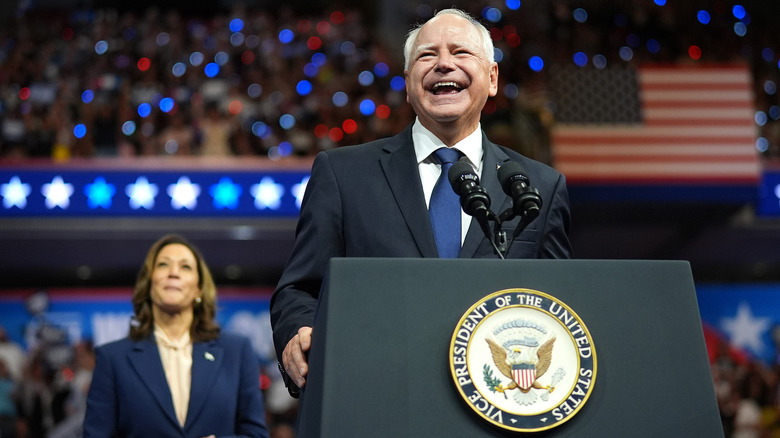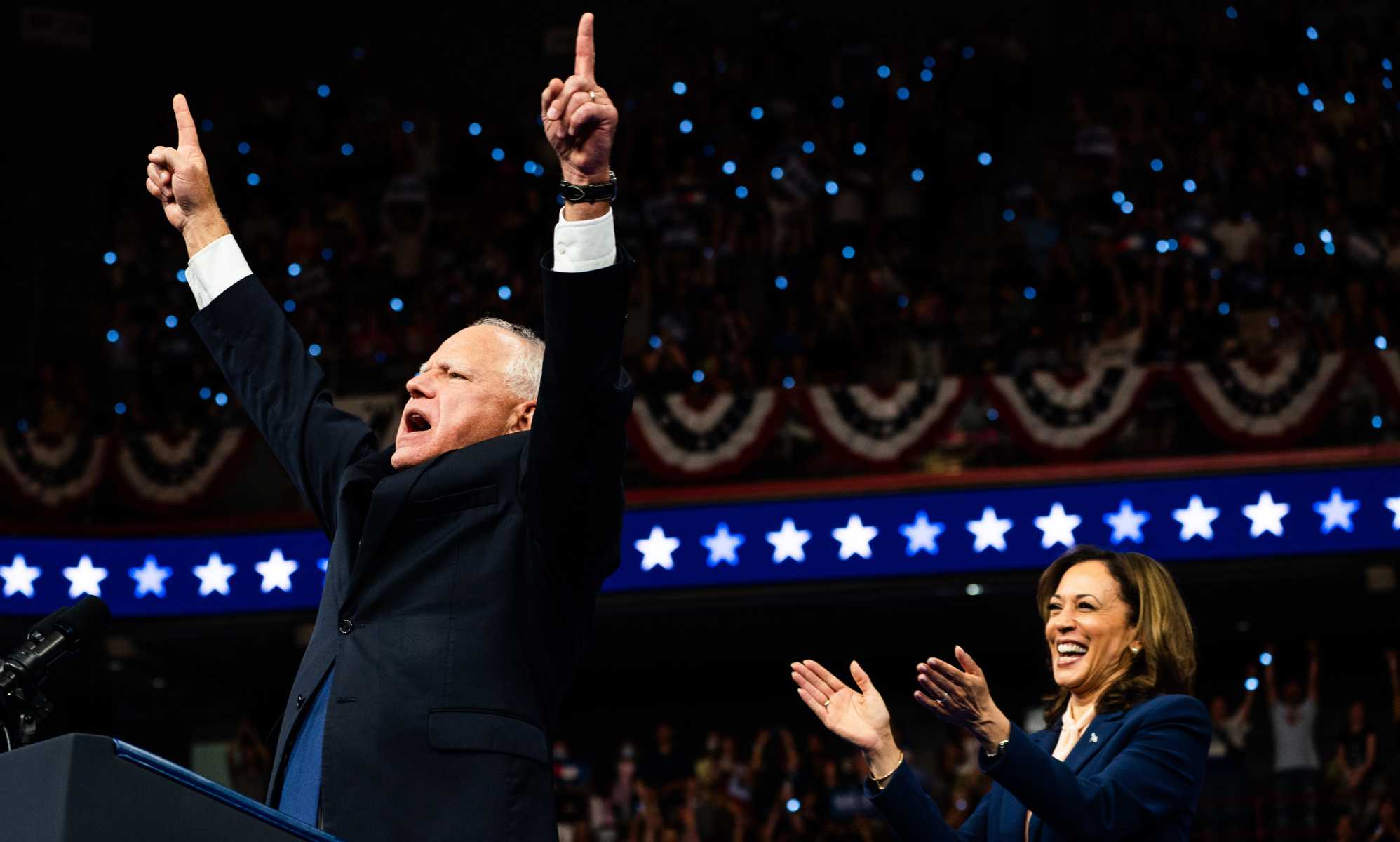Tim Walz

Tim Walz, the current Governor of Minnesota, has a rich background in education, military service, and public service. He has been a prominent figure in Minnesota politics for over two decades, gradually rising through the ranks to become the state’s chief executive.
Early Life and Career
Tim Walz was born and raised in Minnesota, graduating from Mankato West High School. He enlisted in the United States Army after high school, serving for 24 years and rising to the rank of Command Sergeant Major. Following his military service, Walz earned a Bachelor of Arts degree in history from Minnesota State University, Mankato. He then worked as a social studies teacher and football coach at Mankato West High School.
Political Career
Walz’s political career began in 2006 when he was elected to the Minnesota House of Representatives, representing a district in southern Minnesota. He quickly rose to prominence in the House, serving as the chair of the Education Committee and later as the House Majority Leader. In 2018, Walz was elected Governor of Minnesota, defeating incumbent Republican Jeff Johnson.
Key Policies and Initiatives
Governor Walz has implemented a number of key policies and initiatives during his tenure. These include:
- Investing in Education: Governor Walz has prioritized education funding, increasing investments in early childhood education, public schools, and higher education. He has also advocated for policies aimed at improving student outcomes and reducing disparities in education.
- Expanding Healthcare Access: Governor Walz has worked to expand access to affordable healthcare, including expanding Medicaid coverage and supporting policies aimed at lowering healthcare costs.
- Promoting Economic Growth: Governor Walz has implemented policies aimed at promoting economic growth, such as investing in infrastructure, supporting small businesses, and promoting job creation.
- Addressing Climate Change: Governor Walz has committed to addressing climate change, setting ambitious goals for reducing greenhouse gas emissions and investing in clean energy.
Challenges and Successes
Governor Walz has faced a number of challenges during his time in office, including the COVID-19 pandemic, economic downturns, and political polarization. However, he has also achieved a number of successes, including:
- Leading the State Through the COVID-19 Pandemic: Governor Walz took decisive action to address the COVID-19 pandemic, implementing public health measures such as mask mandates and social distancing guidelines. He also worked to secure federal funding for the state and support businesses and individuals affected by the pandemic.
- Investing in Infrastructure: Governor Walz has made significant investments in infrastructure, including roads, bridges, and broadband internet access. These investments are aimed at improving transportation, economic competitiveness, and quality of life for Minnesotans.
- Promoting Racial Equity: Governor Walz has made racial equity a priority, implementing policies aimed at addressing systemic racism and promoting equal opportunities for all Minnesotans.
Political Ideology
Governor Walz is generally considered to be a moderate Democrat. He is a strong advocate for social justice, economic equality, and environmental protection. His political ideology aligns with other prominent Minnesota Democrats such as Senator Amy Klobuchar and Representative Ilhan Omar. However, he has also shown a willingness to work across the aisle on issues such as infrastructure and education.
Minnesota’s Political Landscape: Tim Walz Minnesota

Minnesota’s political landscape has a long and rich history, characterized by a complex interplay of political parties, interest groups, and public opinion. The state’s political culture is often described as progressive and moderate, with a strong emphasis on social welfare and environmental protection.
Historical and Contemporary Trends
Minnesota’s political history is marked by a strong tradition of bipartisanship and a willingness to compromise. The state has a long history of electing both Democrats and Republicans to statewide office, and the two parties have often worked together on issues of common concern. In recent years, however, the state’s political landscape has become increasingly polarized, with the two parties taking more extreme positions on a range of issues.
Influence of Political Parties and Interest Groups
The Democratic-Farmer-Labor Party (DFL) and the Republican Party are the two major political parties in Minnesota. The DFL is generally considered to be more progressive, while the Republican Party is generally considered to be more conservative. However, there is a significant amount of variation within each party, and there are many moderate Democrats and Republicans in the state.
In addition to the major political parties, a variety of interest groups play an important role in Minnesota’s political scene. These groups represent a wide range of interests, including labor unions, business groups, environmental organizations, and social justice advocates. Interest groups often lobby the legislature and the governor on issues that are important to their members. They also play an important role in shaping public opinion and mobilizing voters.
Public Opinion and Voter Demographics
Public opinion in Minnesota is generally considered to be moderate and progressive. The state has a long history of supporting social welfare programs, environmental protection, and education. However, there is significant variation in public opinion across different demographic groups. For example, urban voters tend to be more liberal than rural voters, and younger voters tend to be more progressive than older voters.
Comparison with Other States
Minnesota is often considered to be a politically moderate state. It is consistently ranked among the most liberal states in the United States, but it is also home to a significant number of conservative voters. Compared to other states in the Midwest, Minnesota is generally considered to be more progressive on social issues, such as abortion and same-sex marriage. However, the state is also home to a strong agricultural sector, which gives it a more conservative streak on economic issues.
Current Issues in Minnesota

Minnesota, a state known for its vibrant economy, diverse population, and beautiful natural landscapes, faces a range of pressing issues that impact the lives of its residents. These challenges require thoughtful policy solutions and collaborative efforts to ensure a thriving future for all Minnesotans.
Economic Development and Job Creation
Economic development and job creation are crucial for Minnesota’s prosperity. The state boasts a strong economy, but challenges remain, including the need to attract and retain skilled workers, foster innovation, and support small businesses.
The state government is actively working to address these issues through various initiatives. For instance, Minnesota has invested in infrastructure projects, such as road and bridge improvements, to enhance connectivity and facilitate economic growth. The state also provides incentives for businesses to locate and expand in Minnesota, including tax breaks and workforce training programs.
“Minnesota’s economy is strong, but we must continue to invest in education, infrastructure, and innovation to ensure that all Minnesotans have the opportunity to succeed.” – Tim Walz, Governor of Minnesota
Education and Workforce Development
Minnesota has a strong tradition of high-quality education, but challenges remain in ensuring equitable access to quality education and preparing students for the workforce. The state is committed to addressing these issues through investments in early childhood education, K-12 schools, and higher education.
The state is also focused on expanding workforce development programs to help Minnesotans acquire the skills needed for in-demand jobs. These programs include apprenticeships, job training, and career counseling.
“A strong education system is essential for a thriving economy and a vibrant society. We must ensure that all Minnesotans have access to quality education, regardless of their background or zip code.” – Tim Walz, Governor of Minnesota
Healthcare and Social Services
Healthcare and social services are essential for the well-being of Minnesotans. The state faces challenges in providing affordable and accessible healthcare, supporting vulnerable populations, and addressing mental health issues.
The state government is committed to expanding access to affordable healthcare through initiatives such as the MinnesotaCare program, which provides health insurance to low- and moderate-income Minnesotans. The state is also investing in mental health services and programs to support individuals and families in need.
“Healthcare is a right, not a privilege. We must work to ensure that all Minnesotans have access to affordable and quality healthcare.” – Tim Walz, Governor of Minnesota
Environmental Protection and Climate Change
Minnesota is a state with abundant natural resources, but the state faces challenges in protecting its environment and addressing the impacts of climate change. The state government is committed to protecting its natural resources through initiatives such as clean energy development, water quality protection, and forest management.
The state is also working to reduce greenhouse gas emissions and mitigate the impacts of climate change through investments in renewable energy, energy efficiency, and transportation infrastructure.
“We have a responsibility to protect our environment for future generations. We must act now to address climate change and ensure a sustainable future for Minnesota.” – Tim Walz, Governor of Minnesota
Infrastructure and Transportation
Minnesota has a robust infrastructure system, but the state faces challenges in maintaining and upgrading its roads, bridges, and public transportation systems. The state government is committed to investing in infrastructure to ensure safe and efficient transportation for all Minnesotans.
The state is investing in projects to improve roads, bridges, and public transportation, as well as to expand broadband access in rural areas.
“A modern and efficient infrastructure is essential for a thriving economy and a strong quality of life. We must invest in our roads, bridges, and public transportation to ensure that Minnesota remains a competitive and connected state.” – Tim Walz, Governor of Minnesota
Public Safety and Criminal Justice, Tim walz minnesota
Public safety and criminal justice are critical concerns for Minnesotans. The state faces challenges in addressing crime, ensuring public safety, and reforming the criminal justice system.
The state government is committed to ensuring public safety through initiatives such as law enforcement funding, community policing, and crime prevention programs. The state is also working to reform the criminal justice system to address issues such as racial disparities and mass incarceration.
“We must work to ensure that all Minnesotans feel safe in their communities. We must also reform our criminal justice system to ensure fairness and equity for all.” – Tim Walz, Governor of Minnesota
Tim walz minnesota – Governor Tim Walz of Minnesota has been a vocal advocate for public health measures, including urging residents to get vaccinated. While navigating the complexities of the pandemic, the state also faces issues like a recent Walmart candy recall , highlighting the importance of consumer safety alongside public health initiatives.
As Walz continues to lead Minnesota through challenging times, he must balance these diverse priorities.
Tim Walz, the governor of Minnesota, has been a prominent figure in the state’s political landscape for several years. While his focus has primarily been on issues like education, healthcare, and the economy, recent events like the helicopter crash into a Hilton hotel in a neighboring state have highlighted the importance of safety and preparedness across the country.
Governor Walz’s administration has been actively involved in ensuring that Minnesota is well-equipped to handle similar situations, should they arise.
